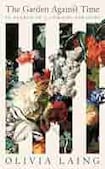
That gardening was a lockdown obsession – Olivia Laing cites the statistic that three million people in Britain took up gardening in 2020 (you wonder how many kept it up) – shows how much the enchantment of gardening comes from its “suspension, its seeming separation” from the wider world, as Olivia Laing puts it in The Garden Against Time. Every hortus, it seems, is its own conclusus.
[ Old favourites: Modern Nature by Derek JarmanOpens in new window ]
It is the strength of Laing’s book to offer an alternative view of the garden, not only as a refuge but also as a source of ideas vital for a changing world – one of a resurgent authoritarian politics, nature degradation and climate change – without breaking the spell of the garden as a form of communal paradise.
Her present task is to restore the gardens created by Mark Rummery, a self-effacing yet influential landscape gardener, whose Suffolk house Laing and her partner Ian moved into during the pandemic. As the years roll on, Laing ensures that the steady work of planting, weeding and caring for a garden is never entirely divorced from the outside world, however odd the juxtaposition might seem. Trump supporters are storming the Capitol as Laing is cutting the first fragrant twigs of Daphne. A new lockdown is announced, and Laing is planting fritillary under the plum tree.
[ The Accidental Garden by Richard Mabey: An instructive and exciting volumeOpens in new window ]
Laing takes her cue from Sebald – who must have walked past her gardened paradise house on his famous walk through Suffolk in 1992 – to reflect on the transformation of the local landscape. The property magnate John Hunt turned the grounds of his large country pile, Heveningham Hall, into a faux 18th-century landscape using rediscovered plans by Capability Brown. Laing’s eyes are opened by this relation of power and landscape to the “expensive forgery of the 18th century” which might describe her own garden. The first extreme heat even in England brings home to Laing the contradiction of gardening as both an ethically acceptable nurturing of nature and a “private luxury at a shared cost” – a refuge from insufferable temperatures unavailable to those without gardens.
[ How to cope with a slope: Challenges of the Irish gardenOpens in new window ]
Laing drops plumb-lines, as she puts it, through time, searching out her obsession with a new Eden. She writes an account of a nearby estate, Shrubland, near Ipswich, evoking the bleakness of a garden based on massive profits from the trade in enslaved people. Laing comes in from the garden to research different ideas of paradise, producing highly engaging chapters on Milton, John Clare, William Morris, Derek Jarman and Iris Origo, who is introduces “like Dorothea from Middlemarch”, tending her vast estate in the Val d’Orcia, but ends risking her life sheltering partisans and deserters from the fascists. Only with the arrival of the Allies and the end of the war can she return, the garden becoming once again a symbol of hope and forward-looking, an epitome of Laing’s vision of the garden paradise “to see the horizon widening, instead of narrowing[…] there is still jasmine on the wall and there are still fireflies in the corn”.














